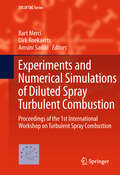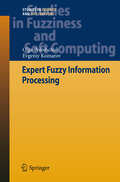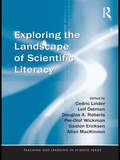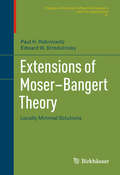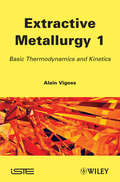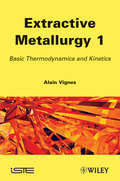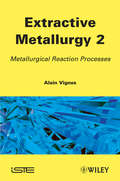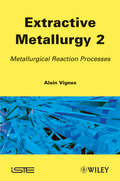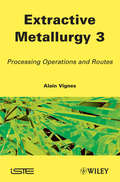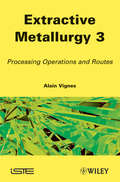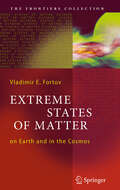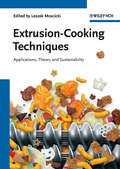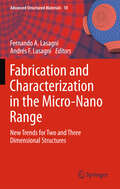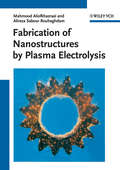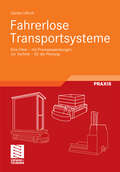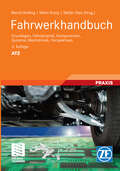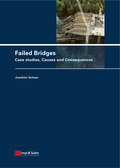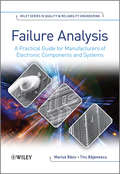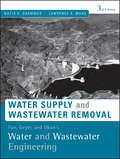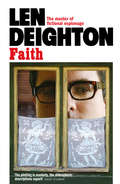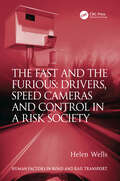- Table View
- List View
Experiments and Numerical Simulations of Diluted Spray Turbulent Combustion: Proceedings of the 1st International Workshop on Turbulent Spray Combustion (ERCOFTAC Series #17)
by Bart Merci, Dirk Roekaerts and Amsini SadikiThis book reflects the outcome of the 1st International Workshop on Turbulent Spray Combustion held in 2009 in Corsica (France). The focus is on reporting the progress of experimental and numerical techniques in two-phase flows, with emphasis on spray combustion. The motivation for studies in this area is that knowledge of the dominant phenomena and their interactions in such flow systems is essential for the development of predictive models and their use in combustor and gas turbine design. This necessitates the development of accurate experimental methods and numerical modelling techniques. The workshop aimed at providing an opportunity for experts and young researchers to present the state-of-the-art, discuss new developments or techniques and exchange ideas in the areas of experimentations, modelling and simulation of reactive multiphase flows.The first two papers reflect the contents of the invited lectures, given by experts in the field of turbulent spray combustion. The first concerns computational issues, while the second deals with experiments. These lectures initiated very interesting and interactive discussions among the researchers, further pursued in contributed poster presentations. Contributions 3 and 4 focus on some aspects of the impact of the interaction between fuel evaporation and combustion on spray combustion in the context of gas turbines, while the final article deals with the interaction between evaporation and turbulence.
Expert Fuzzy Information Processing (Studies in Fuzziness and Soft Computing #268)
by Olga Poleshchuk Evgeniy KomarovThis book deals with expert evaluation models in the form of semantic spaces with completeness and orthogonality properties (complete orthogonal semantic spaces). Theoretical and practical studies of some researchers have shown that these spaces describe expert evaluations most adequately, and as a result they were often included in more sophisticated models of intellectual systems for decision making and data analysis. Methods for constructing expert evaluation models of characteristics, comparative analysis of these models, studies of structural composition of their sets and constructing of generalized models are described. Models to obtain rating points for objects and groups of objects with qualitative and quantitative characteristics are presented. A number of regression models combining elements of classical and fuzzy regressions are presented. All methods and models developed by the authors and described in the book are illustrated with examples from various fields of human activities.This book meant for scientists in the field of computer science, expert systems, artificial intelligence and decision making; and also for engineers, post-graduate students and students who study the fuzzy set theory and its applications.
Exploring the Landscape of Scientific Literacy (Teaching and Learning in Science Series)
by Cedric LinderScientific literacy is part of national science education curricula worldwide. In this volume, an international group of distinguished scholars offer new ways to look at the key ideas and practices associated with promoting scientific literacy in schools and higher education. The goal is to open up the debate on scientific literacy, particularly around the tension between theoretical and practical issues related to teaching and learning science. Uniquely drawing together and examining a rich, diverse set of approaches and policy and practice exemplars, the book takes a pragmatic and inclusive perspective on curriculum reform and learning, and presents a future vision for science education research and practice by articulating a more expansive notion of scientific literacy.
Exploring the Landscape of Scientific Literacy (Teaching and Learning in Science Series)
by Cedric Linder Leif Östman Douglas A. Roberts Per-Olof Wickman Gaalen Ericksen Allan MacKinnonScientific literacy is part of national science education curricula worldwide. In this volume, an international group of distinguished scholars offer new ways to look at the key ideas and practices associated with promoting scientific literacy in schools and higher education. The goal is to open up the debate on scientific literacy, particularly around the tension between theoretical and practical issues related to teaching and learning science. Uniquely drawing together and examining a rich, diverse set of approaches and policy and practice exemplars, the book takes a pragmatic and inclusive perspective on curriculum reform and learning, and presents a future vision for science education research and practice by articulating a more expansive notion of scientific literacy.
Extensions of Moser–Bangert Theory: Locally Minimal Solutions (Progress in Nonlinear Differential Equations and Their Applications #81)
by Paul H. Rabinowitz Edward W. StredulinskyThis self-contained monograph presents extensions of the Moser–Bangert approach that include solutions of a family of nonlinear elliptic PDEs on Rn and an Allen–Cahn PDE model of phase transitions. After recalling the relevant Moser–Bangert results, Extensions of Moser–Bangert Theory pursues the rich structure of the set of solutions of a simpler model case, expanding upon the studies of Moser and Bangert to include solutions that merely have local minimality properties. The work is intended for mathematicians who specialize in partial differential equations and may also be used as a text for a graduate topics course in PDEs.
Extractive Metallurgy 1: Basic Thermodynamics and Kinetics (Iste Ser.)
by Alain VignesThis book is dedicated to the processes of mineral transformation, recycling and reclamation of metals, for the purpose of turning metals and alloys into a liquid state ready for pouring. Even though "process metallurgy" is one of the oldest technologies implemented by man, technological innovation, with the development of processes that are both focused on product quality and economically and ecologically efficient, continues to be at the heart of these industries. This book explains the physico-chemical bases of transformations, vital to their understanding and control (optimization of operational conditions), and the foundations in terms of "process engineering" (heat and matter assessment, process coupling: chemical reactions and transport phenomena), vital to the optimal execution and analysis of transformation process operations. This book is addressed to students in the field of metallurgy and to engineers facing the problem of metal and alloy development (operation of an industrial unit or development of a new process).
Extractive Metallurgy 1: Basic Thermodynamics and Kinetics
by Alain VignesThis book is dedicated to the processes of mineral transformation, recycling and reclamation of metals, for the purpose of turning metals and alloys into a liquid state ready for pouring. Even though "process metallurgy" is one of the oldest technologies implemented by man, technological innovation, with the development of processes that are both focused on product quality and economically and ecologically efficient, continues to be at the heart of these industries. This book explains the physico-chemical bases of transformations, vital to their understanding and control (optimization of operational conditions), and the foundations in terms of "process engineering" (heat and matter assessment, process coupling: chemical reactions and transport phenomena), vital to the optimal execution and analysis of transformation process operations. This book is addressed to students in the field of metallurgy and to engineers facing the problem of metal and alloy development (operation of an industrial unit or development of a new process).
Extractive Metallurgy 2: Metallurgical Reaction Processes (Iste Ser.)
by Alain VignesThe Extractive Metallurgy series is devoted to the extraction of metals from ores and other sources, their refining to the state of either liquid or solid metal, and the various processes needed to carry out these operations. Using the methodology of chemical reaction engineering, this second volume in the series examines on the metallurgical reaction processes used in the extraction and refining operations, covering pyrometallurgical, hydrometallurgical, halide, and electro-metallurgical processes. It provides valuable information on the technologies and processes engineers encounter in industrial production.
Extractive Metallurgy 2: Metallurgical Reaction Processes
by Alain VignesThe Extractive Metallurgy series is devoted to the extraction of metals from ores and other sources, their refining to the state of either liquid or solid metal, and the various processes needed to carry out these operations. Using the methodology of chemical reaction engineering, this second volume in the series examines on the metallurgical reaction processes used in the extraction and refining operations, covering pyrometallurgical, hydrometallurgical, halide, and electro-metallurgical processes. It provides valuable information on the technologies and processes engineers encounter in industrial production.
Extractive Metallurgy 3: Processing Operations and Routes (Iste Ser.)
by Alain VignesExtractive metallurgy is the art and science of extracting metals from their ores and refining them. The production of metals and alloys from these source materials is still one of the most important and fundamental industries in both developed and developing economies around the world. The outputs and products are essential resources for the metallic, mechanical, electromagnetic, electrical and electronics industries (silicon is treated as a metal for these purposes). This series is devoted to the extraction of metals from ores, concentrates (enriched ores), scraps, and other sources and their refining to the state of either liquid metal before casting or to solid metals. The extraction and refining operations that are required may be carried out by various metallurgical reaction processes. Extractive Metallurgy 1 deals with the fundamentals of thermodynamics and kinetics of the reaction processes. Extractive Metallurgy 2 focuses on pyrometallurgical, hydrometallurgical, halide and electro-metallurgical (conversion) processes. Extractive Metallurgy 3 deals with the industrial processing operations, technologies, and process routes, in other words the sequence of steps or operations used to convert the ore to metal. Processes and operations are studied using the methodology of “chemical reaction engineering”. As the fundamentals of the art and science of Extractive Metallurgy are infrequently taught as dedicated university or engineering schools courses, this series is intended both for students in the fields of Metallurgy and Mechanical Engineering who want to acquire this knowledge, and also for engineers put in charge of the operation of an industrial production unit or the development of a new process, who will need the basic knowledge of the corresponding technology.
Extractive Metallurgy 3: Processing Operations and Routes
by Alain VignesExtractive metallurgy is the art and science of extracting metals from their ores and refining them. The production of metals and alloys from these source materials is still one of the most important and fundamental industries in both developed and developing economies around the world. The outputs and products are essential resources for the metallic, mechanical, electromagnetic, electrical and electronics industries (silicon is treated as a metal for these purposes). This series is devoted to the extraction of metals from ores, concentrates (enriched ores), scraps, and other sources and their refining to the state of either liquid metal before casting or to solid metals. The extraction and refining operations that are required may be carried out by various metallurgical reaction processes. Extractive Metallurgy 1 deals with the fundamentals of thermodynamics and kinetics of the reaction processes. Extractive Metallurgy 2 focuses on pyrometallurgical, hydrometallurgical, halide and electro-metallurgical (conversion) processes. Extractive Metallurgy 3 deals with the industrial processing operations, technologies, and process routes, in other words the sequence of steps or operations used to convert the ore to metal. Processes and operations are studied using the methodology of “chemical reaction engineering”. As the fundamentals of the art and science of Extractive Metallurgy are infrequently taught as dedicated university or engineering schools courses, this series is intended both for students in the fields of Metallurgy and Mechanical Engineering who want to acquire this knowledge, and also for engineers put in charge of the operation of an industrial production unit or the development of a new process, who will need the basic knowledge of the corresponding technology.
Extreme States of Matter: on Earth and in the Cosmos (The Frontiers Collection)
by Vladimir E. FortovWith its many beautiful colour pictures, this book gives fascinating insights into the unusual forms and behaviour of matter under extremely high pressures and temperatures. These extreme states are generated, among other things, by strong shock, detonation and electric explosion waves, dense laser beams, electron and ion beams, hypersonic entry of spacecraft into dense atmospheres of planets, and in many other situations characterized by extremely high pressures and temperatures.Written by one of the world's foremost experts on the topic, this book will inform and fascinate all scientists dealing with materials properties and physics, and also serve as an excellent introduction to plasma-, shock-wave and high-energy-density physics for students and newcomers seeking an overview.
Extrusion-Cooking Techniques: Applications, Theory and Sustainability
by Leszek MoscickiOffering an engineering perspective and the latest information on the application of this rapidly expanding technique, this practical book covers the technology, engineering, materials and products, as well as economic and ecological aspects. In addition to the theory, it also utilizes case studies that can easily be put into industrial practice. Each step of the process is discussed in terms of sustainability, and all data complies with the EU and FTA environmental regulations. Invaluable reading for food chemists and technologists, process engineers, chemists in industry, agricultural scientists, and chemical engineers. From the Contents: * Engineering Aspects of Extrusion * Raw Materials in the Production of Extrudates * Production of Breakfast Cereals, Snack Pellets, Baby Food and more * Extrusion Technique in Confectionery * Pet Food and Aquafeed * Extrusion-Cooking in Waste Management and Paper Pulp Processing * Thermoplastic Starch * Expanders * Process Automation * Scale-Up of Extrusion-Cooking in Single-Screw Extruders
Fabrication and Characterization in the Micro-Nano Range: New Trends for Two and Three Dimensional Structures (Advanced Structured Materials #10)
by Fernando A. A. Lasagni and Andrés F. F. LasagniThis book shows an update in the field of micro/nano fabrications techniques of two and three dimensional structures as well as ultimate three dimensional characterization methods from the atom range to the micro scale. Several examples are presented showing their direct application in different technological fields such as microfluidics, photonics, biotechnology and aerospace engineering, between others. The effects of the microstructure and topography on the macroscopic properties of the studied materials are discussed, together with a detailed review of 3D imaging techniques.
Fabrication of Nanostructures by Plasma Electrolysis
by Mahmood Aliofkhazraei Alireza Sabour RouhaghdamIn this handbook and ready reference, the authors introduce the concept of plasma electrolysis, explaining how the coatings are characterized and discussing their mechanical and corrosion properties. They then go on to look at specific industrial applications of this powerful and low-cost method, including aerospace, the biomaterials industry as well as in the oil and gas industry.
Fahrerlose Transportsysteme: Eine Fibel - mit Praxisanwendungen - zur Technik - für die Planung (Fortschritte der Robotik #22)
by Günter UllrichFahrerlose Transportsysteme sind flexible, aber mitunter komplexe Materialflusssysteme für die Intralogistik. Die Marktdurchdringung in den bekannten Anwendungsbereichen wächst ebenso wie die Chancen in neuen Märkten. Der Anwender und Planer solcher Systeme hat die Möglichkeit, große Rationalisierungspotentiale in seiner Intralogistik zu schöpfen, braucht dafür aber umfangreiche Informationen. Die FTS-Fibel zeigt, wie und wo man FTS einsetzen kann und wie die wichtigsten technischen Komponenten aufgebaut sind. Darüber hinaus bietet sie praxisnahe Planungsunterstützung.
Fahrwerkhandbuch: Grundlagen, Fahrdynamik, Komponenten, Systeme, Mechatronik, Perspektiven (ATZ/MTZ-Fachbuch)
by Bernhard Heißing Metin Ersoy Stefan GiesTrotz aller Unterstützung durch elektronische Steuerungs- und Regelsysteme kommen Pkw-Fahrwerke der neuesten Generation nicht ohne die konventionellen Fahrwerkelemente aus. Mit Blick auf die Fahrdynamik werden in diesem Band die konventionellen Elemente und deren Zusammenwirken mit mechatronischen Systemen dargestellt. Dabei werden zunächst Grundlagen und Auslegung, danach in besonders praxisnaher Darstellung die Fahrdynamik beschrieben. Es folgen ausführliche Beschreibung und Erläuterung der modernen Komponenten. Ein eigener Abschnitt widmet sich den Achsen und Prozessen für die Achsenentwicklung.
Failed Bridges: Case Studies, Causes and Consequences
by Joachim ScheerWhen bridges fail, often with loss of human life, those involved may be unwilling to speak openly about the cause. Yet it is possible to learn from mistakes. The lessons gained lead to greater safety and are a source of innovation. This book contains a systematic, unprecedented overview of more than 400 bridge failures assigned to the time of their occurrence in the bridges' life cycle and to the releasing events. Primary causes are identified. Many of the cases investigated are published here for the first time and previous interpretations are shown to be incomplete or incorrect. A catalogue of rules that can help to avoid future mistakes in design analysis, planning and erection is included. A lifetime's work brilliantly compiled and courageously presented - a wealth of knowledge and experience for every structural engineer.
Failure Analysis: A Practical Guide for Manufacturers of Electronic Components and Systems (Quality And Reliability Engineering Ser. #7)
by Marius Bazu Titu BajenescuFailure analysis is the preferred method to investigate product or process reliability and to ensure optimum performance of electrical components and systems. The physics-of-failure approach is the only internationally accepted solution for continuously improving the reliability of materials, devices and processes. The models have been developed from the physical and chemical phenomena that are responsible for degradation or failure of electronic components and materials and now replace popular distribution models for failure mechanisms such as Weibull or lognormal. Reliability engineers need practical orientation around the complex procedures involved in failure analysis. This guide acts as a tool for all advanced techniques, their benefits and vital aspects of their use in a reliability programme. Using twelve complex case studies, the authors explain why failure analysis should be used with electronic components, when implementation is appropriate and methods for its successful use. Inside you will find detailed coverage on: a synergistic approach to failure modes and mechanisms, along with reliability physics and the failure analysis of materials, emphasizing the vital importance of cooperation between a product development team involved the reasons why failure analysis is an important tool for improving yield and reliability by corrective actions the design stage, highlighting the ‘concurrent engineering' approach and DfR (Design for Reliability) failure analysis during fabrication, covering reliability monitoring, process monitors and package reliability reliability resting after fabrication, including reliability assessment at this stage and corrective actions a large variety of methods, such as electrical methods, thermal methods, optical methods, electron microscopy, mechanical methods, X-Ray methods, spectroscopic, acoustical, and laser methods new challenges in reliability testing, such as its use in microsystems and nanostructures This practical yet comprehensive reference is useful for manufacturers and engineers involved in the design, fabrication and testing of electronic components, devices, ICs and electronic systems, as well as for users of components in complex systems wanting to discover the roots of the reliability flaws for their products.
Failure Analysis: A Practical Guide for Manufacturers of Electronic Components and Systems (Quality and Reliability Engineering Series #5)
by Marius Bazu Titu BajenescuFailure analysis is the preferred method to investigate product or process reliability and to ensure optimum performance of electrical components and systems. The physics-of-failure approach is the only internationally accepted solution for continuously improving the reliability of materials, devices and processes. The models have been developed from the physical and chemical phenomena that are responsible for degradation or failure of electronic components and materials and now replace popular distribution models for failure mechanisms such as Weibull or lognormal. Reliability engineers need practical orientation around the complex procedures involved in failure analysis. This guide acts as a tool for all advanced techniques, their benefits and vital aspects of their use in a reliability programme. Using twelve complex case studies, the authors explain why failure analysis should be used with electronic components, when implementation is appropriate and methods for its successful use. Inside you will find detailed coverage on: a synergistic approach to failure modes and mechanisms, along with reliability physics and the failure analysis of materials, emphasizing the vital importance of cooperation between a product development team involved the reasons why failure analysis is an important tool for improving yield and reliability by corrective actions the design stage, highlighting the ‘concurrent engineering' approach and DfR (Design for Reliability) failure analysis during fabrication, covering reliability monitoring, process monitors and package reliability reliability resting after fabrication, including reliability assessment at this stage and corrective actions a large variety of methods, such as electrical methods, thermal methods, optical methods, electron microscopy, mechanical methods, X-Ray methods, spectroscopic, acoustical, and laser methods new challenges in reliability testing, such as its use in microsystems and nanostructures This practical yet comprehensive reference is useful for manufacturers and engineers involved in the design, fabrication and testing of electronic components, devices, ICs and electronic systems, as well as for users of components in complex systems wanting to discover the roots of the reliability flaws for their products.
Fair, Geyer, and Okun's, Water and Wastewater Engineering: Water Supply and Wastewater Removal
by Nazih K. Shammas Lawrence K. WangBased on the classic text by Fair, Greyer, and Okun, this new edition has been completely revised and updated including eight completely new chapters by university professors and engineers practicing in the field. It reflects current practice, includes access to an academic version of the commercial software Haestad Methods Water Solutions by Bentley, and now includes homework problems. This is a time of mounting urbanization and industrialization and resulting stress on water and wastewater systems. Clean and ample sources of water for municipal uses are becoming harder to find and more expensive to develop. Effective design and efficient operation of engineering works ask, above all, for a fuller understanding and application of scientific principles. The results of scientific research are being incorporated with remarkable success in new designs using both U.S. and SI systems equations, examples and problems as well as new operating procedures. This classic text, now updated, grounds readers in both the science and art of water and wastewater engineering that global engineers need to service their customers and communities.
Faith (Faith, Hope And Charity Trilogy #Vol. 1)
by Len DeightonBernard Samson returns to Berlin in the first novel in the classic spy trilogy, FAITH, HOPE and CHARITY
A Farmer’s Life for Me: How To Live Sustainably, Jimmiy's Way
by Jimmy DohertyIn this practical guide TV farmer Jimmy Doherty imparts his experience and ideas to show you how to achieve the self-sufficient lifestyle and add to your life whether growing for your own pleasure – or profit!
The Fast and The Furious: Drivers, Speed Cameras and Control in a Risk Society (Human Factors in Road and Rail Transport)
by Helen WellsThe Fast and The Furious: Drivers, Speed Cameras and Control in a Risk Society presents a sociological and criminological perspective critical to understanding the driver's role at the centre of road safety interventions. Such an approach is, it is argued, as crucial to an understanding of attempts to reduce road crashes, deaths and injuries as approaching such questions from an engineering or educational perspective. The book offers an explanation for the continued debate about one road safety intervention - the speed camera - by situating that debate within contemporary literature about the 'risk society' (Beck, 1992) and more broadly understood experiences of risk faced on a daily basis by drivers. Rather than a focus on risk as something that can be objectively assessed, measured and managed separately from the social context in which it is encountered, it suggests that 'risk' is something that permeates this particular debate from every angle. The book achieves its aims by utilising sociological and criminological perspectives to investigate issues such as: - the social context in which it is possible for drivers to reject official scientific expertise about crash causation and camera effectiveness - the self-defined 'respectability' of the population being problematised and its juxtaposition with a 'proper' police focus on 'real criminals' - the reconceptualisation of law-breaking as risk-taking rather than inherently 'wrong' behaviour and its consequences for the enforcement of laws based on risk assessment - the experience of being controlled by technology and of receiving what is essentially 'automated justice'. These and other issues are explored and suggested as illuminating of both the real concerns underpinning this debate and potentially instructive for future attempts to control risky behaviour both within and beyond a road safety context.
The Fast and The Furious: Drivers, Speed Cameras and Control in a Risk Society (Human Factors in Road and Rail Transport)
by Helen WellsThe Fast and The Furious: Drivers, Speed Cameras and Control in a Risk Society presents a sociological and criminological perspective critical to understanding the driver's role at the centre of road safety interventions. Such an approach is, it is argued, as crucial to an understanding of attempts to reduce road crashes, deaths and injuries as approaching such questions from an engineering or educational perspective. The book offers an explanation for the continued debate about one road safety intervention - the speed camera - by situating that debate within contemporary literature about the 'risk society' (Beck, 1992) and more broadly understood experiences of risk faced on a daily basis by drivers. Rather than a focus on risk as something that can be objectively assessed, measured and managed separately from the social context in which it is encountered, it suggests that 'risk' is something that permeates this particular debate from every angle. The book achieves its aims by utilising sociological and criminological perspectives to investigate issues such as: - the social context in which it is possible for drivers to reject official scientific expertise about crash causation and camera effectiveness - the self-defined 'respectability' of the population being problematised and its juxtaposition with a 'proper' police focus on 'real criminals' - the reconceptualisation of law-breaking as risk-taking rather than inherently 'wrong' behaviour and its consequences for the enforcement of laws based on risk assessment - the experience of being controlled by technology and of receiving what is essentially 'automated justice'. These and other issues are explored and suggested as illuminating of both the real concerns underpinning this debate and potentially instructive for future attempts to control risky behaviour both within and beyond a road safety context.
